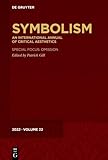Symbolism : An International Annual of Critical Aesthetics / ed. by Florian Klaeger, Klaus Stierstorfer, Marlena Tronicke.
Material type: TextSeries: Symbolism : An International Annual of Critical Aesthetics ; 22Publisher: Berlin ; Boston : De Gruyter, [2022]Copyright date: ©2022Description: 1 online resource (VIII, 281 p.)Content type:
TextSeries: Symbolism : An International Annual of Critical Aesthetics ; 22Publisher: Berlin ; Boston : De Gruyter, [2022]Copyright date: ©2022Description: 1 online resource (VIII, 281 p.)Content type: - 9783110775853
- 9783110775945
- 9783110775884
- 700 23/eng/20230531
- N6465.S9 S94 2022
- online - DeGruyter
- Issued also in print.
| Item type | Current library | Call number | URL | Status | Notes | Barcode | |
|---|---|---|---|---|---|---|---|
 eBook
eBook
|
Biblioteca "Angelicum" Pont. Univ. S.Tommaso d'Aquino Nuvola online | online - DeGruyter (Browse shelf(Opens below)) | Online access | Not for loan (Accesso limitato) | Accesso per gli utenti autorizzati / Access for authorized users | (dgr)9783110775884 |
Frontmatter -- Foreword from the Editors -- Contents -- Special Focus: Omission -- Introduction: Omission -- “[B]y the Knowledge of the Great Saint Paraleipomenon—”: Si(g)ns of Omission in Laurence Sterne -- When Words Stop: Omission in Songs -- Omissions, Blanks, and Silences: Reading Shakespeare’s Sonnet 126 -- Blackness as Disability: Compulsory Whiteness, Able-Bodiedness, and Masculinity in Frances E. W. Harper’s Iola Leroy -- Girls’ Aesthetics in Japan: Absence of Female Material Bodies -- Meliur as a Figure of Omission in Konrad von Würzburg’s Partonopier und Meliur -- Repression and Omission in Kazuo Ishiguro’s A Pale View of Hills -- Don’t Mention the Guns: Omission by Substitution in Simon Armitage’s Killing Time -- Omission and the Poetics of the EC Comics Twist: An Analysis of “Last Respects” (1951) and “Master Race” (1955) -- The Omissions of Intermediality: Pop Music and Jennifer Egan’s A Visit from the Goon Squad -- Aliens in the Void: Writing Beyond the Limits of Language in bpNichol’s The Martyrology (and (Luigi Serafini’s ((Code)x Seriphian(us)))) -- The Mystery of the Missing Mystery: Midcentury Intellectuals on Modernism and Detective Fiction -- General Section -- Nature and I: The Human/Nature Relationship in Surrealist and Proto-Surrealist Poetry -- The Symbolism of the String Quartet in Thomas Mann’s Doctor Faustus -- Contributors -- Index
restricted access online access with authorization star
http://purl.org/coar/access_right/c_16ec
Special Focus: "Omission", edited by Patrick Gill Throughout literary history and in many cultures, we encounter an astute use of conspicuous absences to conjure an imagined reality into a recipient’s mind. The term ‘omission’ as used in the present study, then, demarcates a common artistic phenomenon: a silence, blank, or absence, introduced against the recipient’s generic or experiential expectations, but which nonetheless frequently encapsulates the tenor of the work as a whole. Such omissions can be employed for their affective potential, when emotions represented or evoked by the text are deemed to be beyond words. They can be employed to raise epistemological questions, as when an omission marks the limits of what can be known. Ethical questions can also be approached by means of omissions, as when a character’s voice is omitted, for instance. Finally, omission always carries within it the potential to reflect on the media and genres on which it is brought to bear: as its efficacy depends on the recipient’s generic expectations, omission is frequently characterized by a high degree of meta-discursiveness. This volume investigates the various strategies with which the phenomenon of omission is employed across a range of textual forms and in different cultures to conclusively argue for its status as a highly effective and near-universal form of artistic signification.
Issued also in print.
Mode of access: Internet via World Wide Web.
In English.
Description based on online resource; title from PDF title page (publisher's Web site, viewed 25. Jun 2024)


